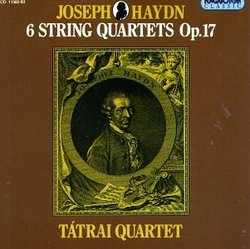| All Artists: Franz Joseph Haydn, Tátrai Quartet Title: Franz Joseph Haydn: String Quartets Op. 17 - Tátrai Quartet Members Wishing: 1 Total Copies: 0 Label: Hungaroton Release Date: 1/18/1995 Album Type: Import Genre: Classical Styles: Chamber Music, Historical Periods, Classical (c.1770-1830) Number of Discs: 2 SwapaCD Credits: 2 UPC: 750582144028 |
Search - Franz Joseph Haydn, Tátrai Quartet :: Franz Joseph Haydn: String Quartets Op. 17 - Tátrai Quartet
 | Franz Joseph Haydn, Tátrai Quartet Franz Joseph Haydn: String Quartets Op. 17 - Tátrai Quartet Genre: Classical
Along with the Op. 9, these pieces are the least familiar in Haydn's epic series of 68-1/2 quartets, works which established this medium as the highest and most profound form of chamber music, and maybe of all music. As wi... more » |
Larger Image |
CD Details
Synopsis
Amazon.com
Along with the Op. 9, these pieces are the least familiar in Haydn's epic series of 68-1/2 quartets, works which established this medium as the highest and most profound form of chamber music, and maybe of all music. As with all transitional works, Op. 17 has something of the character of an experiment--Haydn is still toying with the structure and order of his movements along the way to a fully realized, perfectly balanced classical form. By the time we get to Op. 17 No. 6, he has arrived at his goal, and the rest is history. And because this is Haydn, even those works that show him "playing around" with the musical possibilities are a joy to listen to. --David Hurwitz

 Track Listings (12) - Disc #1
Track Listings (12) - Disc #1